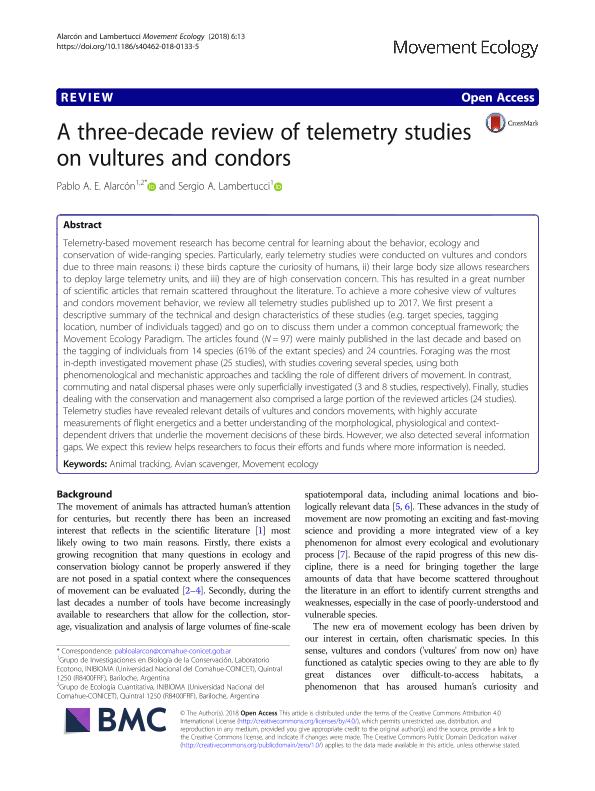Mostrar el registro sencillo del ítem
dc.contributor.author
Alarcón, Pablo Angel Eduardo

dc.contributor.author
Lambertucci, Sergio Agustin

dc.date.available
2019-11-26T21:31:35Z
dc.date.issued
2018-09-04
dc.identifier.citation
Alarcón, Pablo Angel Eduardo; Lambertucci, Sergio Agustin; A three-decade review of telemetry studies on vultures and condors; BioMed Central; Movement Ecology; 6; 1; 4-9-2018; 1-13
dc.identifier.issn
2051-3933
dc.identifier.uri
http://hdl.handle.net/11336/90605
dc.description.abstract
Telemetry-based movement research has become central for learning about the behavior, ecology and conservation of wide-ranging species. Particularly, early telemetry studies were conducted on vultures and condors due to three main reasons: i) these birds capture the curiosity of humans, ii) their large body size allows researchers to deploy large telemetry units, and iii) they are of high conservation concern. This has resulted in a great number of scientific articles that remain scattered throughout the literature. To achieve a more cohesive view of vultures and condors movement behavior, we review all telemetry studies published up to 2017. We first present a descriptive summary of the technical and design characteristics of these studies (e.g. target species, tagging location, number of individuals tagged) and go on to discuss them under a common conceptual framework; the Movement Ecology Paradigm. The articles found (N=97) were mainly published in the last decade and based on the tagging of individuals from 14 species (61% of the extant species) and 24 countries. Foraging was the most in-depth investigated movement phase (25 studies), with studies covering several species, using both phenomenological and mechanistic approaches and tackling the role of different drivers of movement. In contrast, commuting and natal dispersal phases were only superficially investigated (3 and 8 studies, respectively). Finally, studies dealing with the conservation and management also comprised a large portion of the reviewed articles (24 studies). Telemetry studies have revealed relevant details of vultures and condors movements, with highly accurate measurements of flight energetics and a better understanding of the morphological, physiological and context-dependent drivers that underlie the movement decisions of these birds. However, we also detected several information gaps. We expect this review helps researchers to focus their efforts and funds where more information is needed.
dc.format
application/pdf
dc.language.iso
eng
dc.publisher
BioMed Central

dc.rights
info:eu-repo/semantics/openAccess
dc.rights.uri
https://creativecommons.org/licenses/by/2.5/ar/
dc.subject
ANIMAL TRACKING
dc.subject
AVIAN SCAVENGER
dc.subject
MOVEMENT ECOLOGY
dc.subject.classification
Ecología

dc.subject.classification
Ciencias Biológicas

dc.subject.classification
CIENCIAS NATURALES Y EXACTAS

dc.title
A three-decade review of telemetry studies on vultures and condors
dc.type
info:eu-repo/semantics/article
dc.type
info:ar-repo/semantics/artículo
dc.type
info:eu-repo/semantics/publishedVersion
dc.date.updated
2019-10-10T13:54:14Z
dc.journal.volume
6
dc.journal.number
1
dc.journal.pagination
1-13
dc.journal.pais
Reino Unido

dc.journal.ciudad
Londres
dc.description.fil
Fil: Alarcón, Pablo Angel Eduardo. Consejo Nacional de Investigaciones Científicas y Técnicas. Centro Científico Tecnológico Conicet - Patagonia Norte. Instituto de Investigaciones en Biodiversidad y Medioambiente. Universidad Nacional del Comahue. Centro Regional Universidad Bariloche. Instituto de Investigaciones en Biodiversidad y Medioambiente; Argentina. Universidad Nacional del Comahue. Centro Regional Universitario Bariloche. Laboratorio de Ecotono; Argentina
dc.description.fil
Fil: Lambertucci, Sergio Agustin. Consejo Nacional de Investigaciones Científicas y Técnicas. Centro Científico Tecnológico Conicet - Patagonia Norte. Instituto de Investigaciones en Biodiversidad y Medioambiente. Universidad Nacional del Comahue. Centro Regional Universidad Bariloche. Instituto de Investigaciones en Biodiversidad y Medioambiente; Argentina. Universidad Nacional del Comahue. Centro Regional Universitario Bariloche. Laboratorio de Ecotono; Argentina
dc.journal.title
Movement Ecology
dc.relation.alternativeid
info:eu-repo/semantics/altIdentifier/url/https://movementecologyjournal.biomedcentral.com/articles/10.1186/s40462-018-0133-5
dc.relation.alternativeid
info:eu-repo/semantics/altIdentifier/doi/http://dx.doi.org/10.1186/s40462-018-0133-5
Archivos asociados
